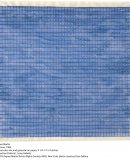Agnes Martin at LACMA

The Los Angeles County Museum of Art is hosting a not-to-miss exhibition through 11 September 2016 surveying the painting of one of the late 20th century’s best artists, Agnes Martin [1912-2004]. Martin is one of those painters you have to see live; no reproduction can mimic the experience of seeing the work in person.
Organized by LACMA, the Tate Modern in London, the Kunstsammlung Nordrhien-Westfalen in Dusseldorf, and the Solomon R. Guggenheim Museum in New York, this exhibition is the first retrospective of her work in the United States since 1992, and will certainly be one of the most important exhibitions in the world this year.
This exhibition is particularly good in that it has not only brought some of her more colorful, mature, classic works together for a rare viewing en masse; but goes to great lengths to show some of her earlier biomorphic abstractions constituting revealing paths of development she abandoned [though still heavily trod by others], and how she worked on small, paper-bound scales in preparation for the 6 x 6 foot classic paintings. The result is a chance to come to a more complete understanding of Martin and her work than has usually been possible with previous exhibitions.
Full disclosure here: I was very struck by Martin’s work when I first saw it in a series of solo shows in New York City in the seventies and the spirit and sense of her work has been a strong influence on my own work ever since.
Martin says that she tried to instill “beauty, innocence, and happiness” into each piece. This exhibition clearly proves that she succeeded in just that, consistently, over a span of many decades.
Martin herself seems to have lived a life of far less happiness and innocence. Suffering from what seems to have been Schizophrenia, the mature work and the paper studies reveal an attempt to impose a rigorous sense of order and process onto her mental state in order to achieve her significant results. The work constitutes a tour de force of restraint, subtlety, and personal expression within totally abstract means.
I also had the good fortune to have been able to visit her studio in the mid-90s at her studio-residence in New Mexico. The opportunity arose quite by accident. I was lost--I had taken a wrong turn near Taos, New Mexico--and the two strangers who came to my aid turned out to be Agnes Martin and a friend out for a walk. She was an extraordinary, gracious, but troubled, soul, who worked under remarkable, isolated conditions to produce these big, beautiful, oh-so-subtle paintings which were then shipped off to New York. There was a certain child-like grace about her that was very striking and that, I feel, shows up strongly in her best work, but hard to get in a photograph. In reproduction, her work tends to look much colder than it actually is. Up close, in person the work reveals the evidence of finely crafted, hand-made-ness that gives some hint of her process.
It goes without saying that Martin’s aesthetic and reclusive lifestyle has inspired countless other artists. She originally emerged within a truly male-dominated art world in New York City as an advocate of pure abstraction. Then, in 1967, on the cusp of stardom, Martin abruptly abandoned her studio and everything in it, left New York City and disappeared.
It turned out she had traveled around the United States and Canada then settled on a mesa in northern New Mexico, returning to painting in 1973. This was followed by a series of solo shows at a major New York Gallery [the ones that I saw] that came as a revelation. The purity, beauty, consistency, austerity, and subtle power of the new work astounded many in the art world and quickly propelled a global demand for her work. Her paintings now sit in almost every major modern museum collection in the world.
In the ensuing three decades, in spite of the new fame and the surely increased income, Martin seems to have not altered one bit the lifestyle that led her to her mature style, working at a high level in reclusion for the rest of her life. Though she visited from time to time, she never really returned to New York City either, but the presence of her work there was indelible and unmistakable.
------------------
Agnes Martin at the Los Angeles County Museum of Art, through 11 September 2016.
Information at lacma.org/art/exhibition/agnes-martin.

